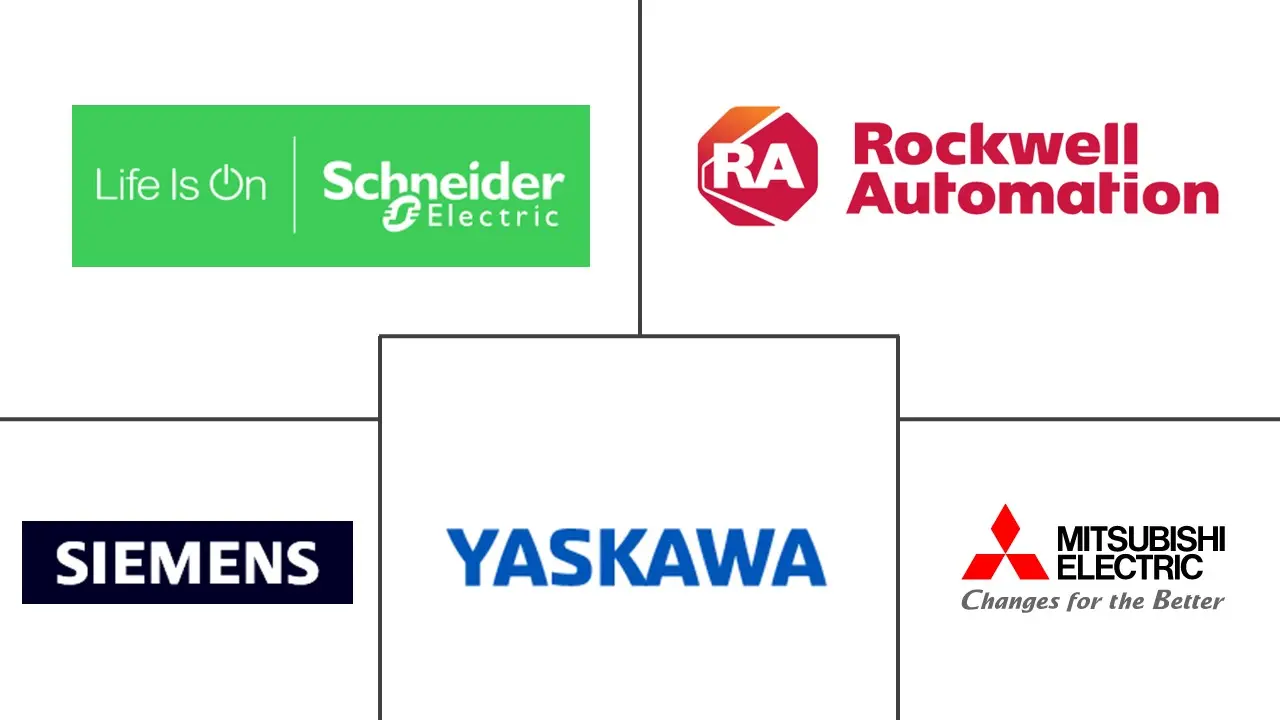Servo Motors And Drives Market Size and Share
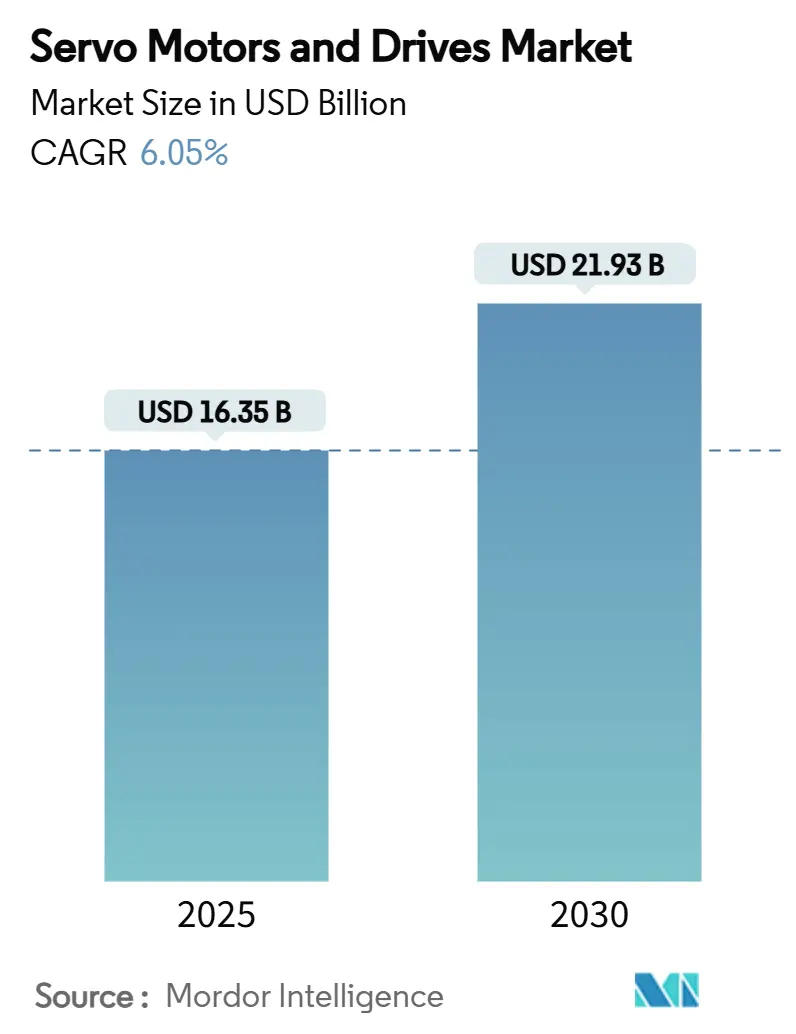
Servo Motors And Drives Market Analysis by Mordor Intelligence
The servo motors and drives market size stood at USD 16.35 billion in 2025 and was forecast to reach USD 21.93 billion by 2030, reflecting a 6.05% CAGR over the period. Growth stemmed from factories upgrading to networked motion systems that combine silicon-carbide power electronics, digital twin simulation and collaborative robotics. Semiconductor plants and precision packaging lines adopted linear designs to eliminate mechanical conversions, while automotive producers invested in mid-voltage, high-power solutions for battery and e-axle assembly. Energy-efficiency legislation prompted manufacturers to replace induction units with IE4-class servo packages, and the expanding 800 V electric-vehicle architecture spurred demand for higher-voltage drives. Intensifying competition arrived from silicon-carbide specialists and cybersecurity vendors, pressuring traditional incumbents to blend mechanical expertise with digital intelligence.
Key Report Takeaways
- By product type, AC units led with 65.5% revenue share in 2024, whereas linear motors advanced at a 9.8% CAGR to 2030.
- By voltage range, low-voltage systems held 62.4% of the servo motors and drives market share in 2024, while medium-voltage platforms expanded at a 7.2% CAGR through 2030.
- By end-user, automotive and EV manufacturing commanded 34.2% share of the servo motors and drives market size in 2024; semiconductor and electronics posted the fastest 9.7% CAGR.
- By power rating, motors of 5-15 kW accounted for 8.1% growth, although ≤1 kW units retained a 37.3% share of the servo motors and drives market size in 2024.
- By geography, Asia-Pacific captured 46.3% revenue in 2024 and remained the fastest-growing region at 7.8% CAGR to 2030.
Global Servo Motors And Drives Market Trends and Insights
Drivers Impact Analysis
| Driver | (~) % Impact on CAGR Forecast | Geographic Relevance | Impact Timeline |
|---|---|---|---|
| Rapid industrial automation and smart-factory rollout | +1.8% | Global, early gains in Germany, Japan, South Korea | Medium term (2-4 years) |
| Rising adoption of collaborative and mobile robotics | +1.2% | North America and EU, spill-over to Asia-Pacific core | Short term (≤ 2 years) |
| Stringent global and regional energy-efficiency mandates | +0.9% | EU leading, North America following, Asia-Pacific selective adoption | Long term (≥ 4 years) |
| Electrification push in automotive manufacturing and EV platforms | +1.5% | Global, concentrated in China, Germany, United States | Medium term (2-4 years) |
| Silicon-carbide power modules boosting drive efficiency | +0.7% | Japan, Germany, United States | Long term (≥ 4 years) |
| Digital-twin-enabled sizing and optimisation of servo systems | +0.4% | Germany, Japan, United States | Long term (≥ 4 years) |
| Source: Mordor Intelligence | |||
Rapid industrial automation and smart-factory rollout
During 2024, automotive groups in Germany connected multi-axis robotic cells to digital-twin platforms, cutting line-change times and increasing throughput. Closure Systems International lifted overall equipment effectiveness to 97.5% after installing FANUC servo-driven lines that dropped unplanned downtime to 2.5%[1]FANUC America, “AI Servo Monitor,” fanucamerica.com. EtherCAT-enabled drives synchronised motion within microseconds, supporting flexible manufacturing and paving the way for 5G-based machine coordination.
Rising adoption of collaborative and mobile robotics
Cobots require compact, safety-rated actuators with integrated torque sensing. Yaskawa’s HC series met ISO/TS 15066:2016 force limits through embedded monitoring, allowing direct human interaction on assembly lines. High-torque-density motors supplied by Kollmorgen powered almost 1 million robotic joints worldwide, demonstrating the servo motors and drives market’s shift toward lighter, user-friendly platforms.
Stringent global and regional energy-efficiency mandates
The European Union enforced IE4 standards for 75-200 kW machines from July 2023, obliging OEMs to update motion systems. The United States Department of Energy proposed rules that could save 8.9 quadrillion Btu between 2029 and 2058 for expanded-scope motors. Silicon-carbide switches enabled drives to meet these targets without oversizing cooling stages, reinforcing demand for high-efficiency solutions.
Electrification push in automotive manufacturing and EV platforms
Battery-pack, motor-housing, and e-axle assembly lines adopted servo-controlled presses that logged real-time force data, cutting scrap in Liuzhou production by replacing pneumatic presses. Tesla used servo presses to ensure uniform pressure on cylindrical cells, supporting gigafactory output ramp-ups. The servo motors and drives market benefited as OEMs scaled 800 V platforms requiring faster, more precise joining operations.
Restraints Impact Analysis
| Restraint | (~) % Impact on CAGR Forecast | Geographic Relevance | Impact Timeline |
|---|---|---|---|
| High upfront cost vs. induction/stepper alternatives | -1.1% | India, Southeast Asia, Latin America | Short term (≤ 2 years) |
| Proliferation of low-cost stepper and VFD-controlled induction motors | -0.8% | China, India, Eastern Europe | Medium term (2-4 years) |
| Supply-chain risk for high-grade rare-earth permanent magnets | -1.3% | Global, acute in North America and Europe | Short term (≤ 2 years) |
| Cyber-vulnerabilities in networked drives | -0.6% | Germany, United States, Japan | Medium term (2-4 years) |
| Source: Mordor Intelligence | |||
High upfront cost vs. induction/stepper alternatives
Small manufacturers in India and Southeast Asia compared premium servo packages with variable-frequency-drive induction sets and frequently chose the latter. Yet studies by Packaging World showed lifetime energy and maintenance savings tilting favour back toward servos, with annual operating cost dropping from USD 7,320 to USD 388.8 when pneumatics were replaced by electric actuators.
Supply-chain risk for high-grade rare-earth permanent magnets
China’s licence rules on neodymium magnet exports in April 2025 delayed shipments to European auto suppliers, leading to short production halts. Tesla’s humanoid-robot programme required up to 4 kg of magnets per unit, widening exposure to supply shocks. ZF responded by launching an I2SM motor that removed rare-earth content and cut energy losses 15%.
Segment Analysis
By Product Type: Linear Designs Lead Precision Applications
AC units kept 65.5% of the servo motors and drives market in 2024 because three-phase grids and mature manufacturing lines favoured rotary designs. Linear variants captured semiconductor packaging, lithography and high-speed cartooning, expanding at 9.8% CAGR. Delkor’s cartoning lines achieved higher throughputs by eliminating rotary-to-linear conversions[2]Delkor Systems, “Linear Servo Motor Permits Unique Cartoning System,” automationworld.com.
Linear models extended beyond simple positioning. Tolomatic servo presses delivered 80% efficiency versus 50% for hydraulics, attracting packaging firms that needed hygienic, oil-free motion. Platform suppliers responded with distributed drives such as Rockwell Automation’s ArmorKinetix, cutting cabling 90% and installation time 30%.
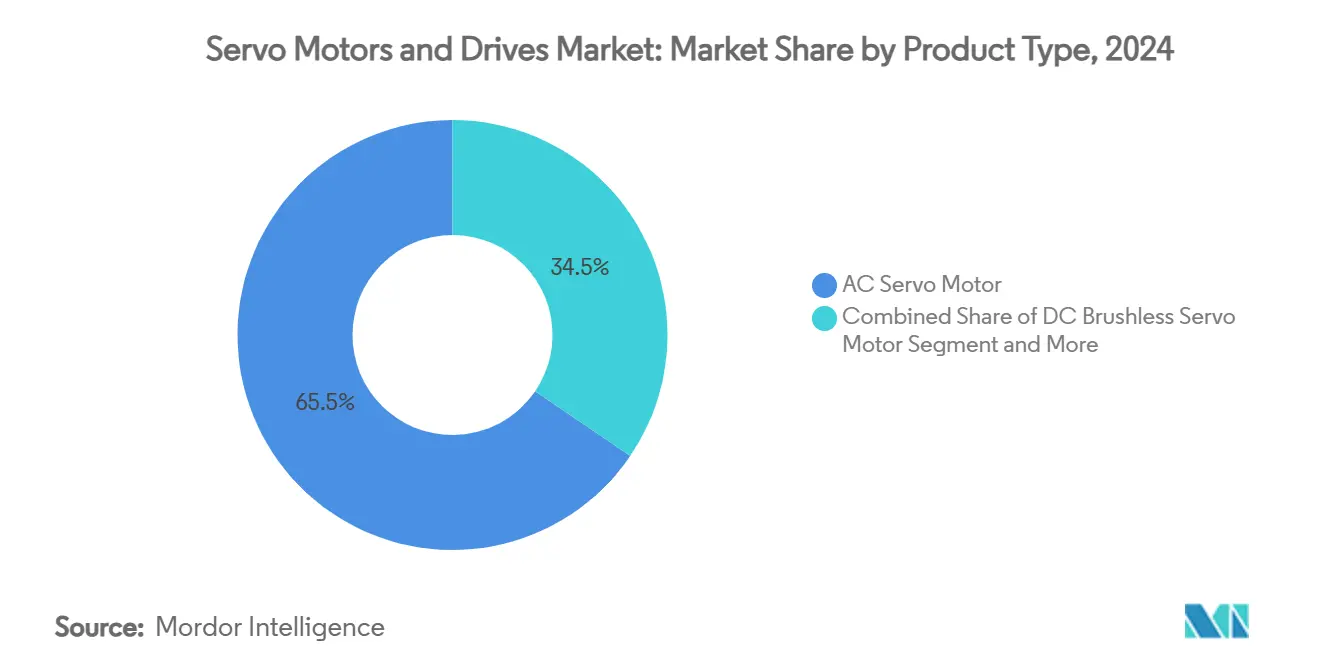
Note: Segment shares of all individual segments available upon report purchase
By Voltage Range: Mid-Voltage Solutions Elevate Power Density
Low-voltage installations held 62.4% share but the 1-35 kV class grew 7.2% annually as plants adopted higher-voltage architectures to reduce cable size and heat. Arrow Electronics highlighted silicon-carbide MOSFETs running at higher switching frequencies with lower losses. Medium-voltage drives supported 100 kW-plus machine tools used for EV motor housings, matching growing torque demands.
Siemens introduced MICRO-DRIVE extra-low-voltage units for autonomous mobile robots that need safe 24-48 V levels. Conversely, 800 V EV lines deployed mid-voltage servos to shrink conductor diameters and lower resistive loss, holding a niche but rising share in the servo motors and drives market.
By End-user Industry: Semiconductor Lines Challenge Automotive Dominance
Automotive retained 34.2% of revenue, fuelled by expanding EV capacity in China, Germany and the United States. Yet semiconductor fabrication and advanced packaging recorded the fastest 9.7% CAGR as lithography steppers and CoWoS tools demanded sub-micron positioning. Delta Electronics supplied linear pocket actuators for Ta Liang’s advanced packages, displacing Japanese imports.
Healthcare device makers adopted servo-controlled surgical robots for minimally invasive procedures, while packaging firms relied on quick-change drives for SKU flexibility. Oil and gas operators specified servo valve actuators that coped with corrosive fluids and high temperatures, saving energy over pneumatic throttling.
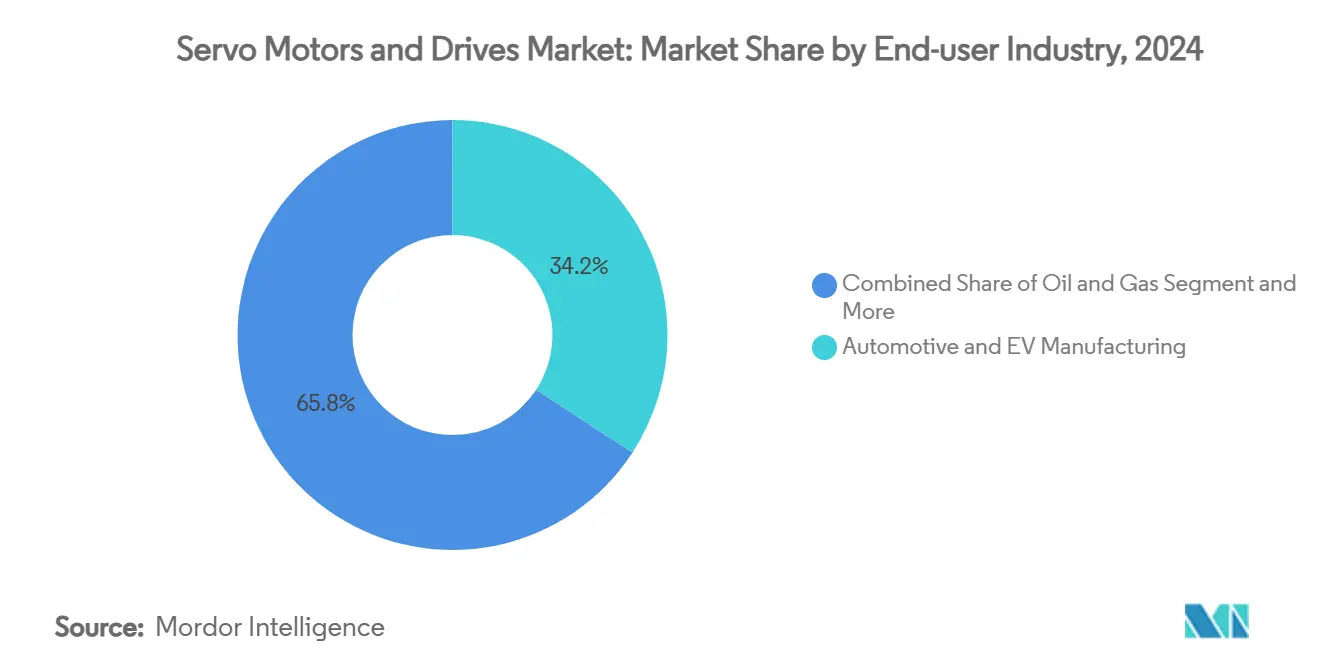
Note: Segment shares of all individual segments available upon report purchase
By Power Rating: Mid-Range Motors Enable Throughput Scaling
Units ≤1 kW comprised 37.3% of the servo motors and drives market size during 2024, serving SCARA arms and collaborative robots. The 5-15 kW class advanced at 8.1% CAGR, powering battery-tray tightening and extrusion lines that required higher torque yet compact footprints. Mitsubishi’s HG-SR series offered up to 100 Nm peak torque for such applications.
Above 15 kW, adoption remained niche but benefited from 800 V EV architectures. ECM PCB Stator Tech’s “Eight Ball” motor packed 18.8 Nm into a palm-sized envelope, hinting at higher-power density trends.
Geography Analysis
Asia-Pacific captured 46.3% of global revenue in 2024 on the back of Chinese electronics production, Japanese technology leadership and India’s factory expansions. Regional growth remained the fastest at 7.8% CAGR as ASEAN nations incentivised automation to raise competitiveness. China’s dominance in rare-earth supply lowered local costs but exposed foreign buyers to export controls. Japan’s Harmonic Drive Systems aimed for JPY 90 billion net sales by FY 2026, reinforcing the technology cluster in Tokyo and Nagano.
North America increased its reshoring programmes to improve supply resilience. Mitsubishi Electric’s USD 143.5 million compressor plant in Kentucky illustrated the trend toward localised production and shorter lead times. Hitachi’s purchase of Joliet Electric Motors broadened aftermarket services, supporting lifecycle value across installed fleets. Rising collaborative-robot utilisation in the United States offset softness in heavy industry.
Europe focused on decarbonisation and digital-twin analytics. IE4 mandates spurred retrofits in Germany and the Nordics, while cybersecurity concerns prompted audits after CISA flagged vulnerabilities in ABB Drive Composer and Rockwell PowerFlex firmware[3]DC Velocity, “Mitsubishi Electric buys stake in Realtime Robotics,” dcvelocity.com Source: CISA, “ABB Drive Composer,” cisa.gov . Medium-voltage drives penetrated automotive clusters in Bavaria and Piedmont as OEMs migrated to 800 V battery lines, sustaining mid-single-digit growth despite macroeconomic pressures.

Competitive Landscape
The servo motors and drives market featured moderate concentration. Yaskawa, Mitsubishi Electric and Siemens continued to anchor global share but faced erosion from silicon-carbide and software-defined newcomers. Yaskawa’s FY 2024 first-half revenue slipped 9.5% year-on-year due to weaker Chinese demand, yet the company reinvested in mechatronics innovation to defend share.
Mitsubishi Electric diversified by acquiring stakes in Realtime Robotics for collision-free path planning and Formic Technologies for robots-as-a-service, signalling a shift toward subscription models. Siemens provided digital-twin platforms coupled with extra-low-voltage drives to lock in software-hardware ecosystems.
Component specialists emerged as disruptors. Silicon-carbide module makers supplied 3.3 kV HVIGBT units with 15% lower switching loss, improving drive efficiency in trains and heavy industry. Cybersecurity firms capitalised on CISA advisories to market intrusion-detection layers for networked motion systems, turning operational-technology security into a purchase criterion alongside torque and speed.
Servo Motors And Drives Industry Leaders
-
Yaskawa Electric Corp.
-
Mitsubishi Electric Corp.
-
Siemens AG
-
Schneider Electric
-
Rockwell Automation, Inc.
- *Disclaimer: Major Players sorted in no particular order
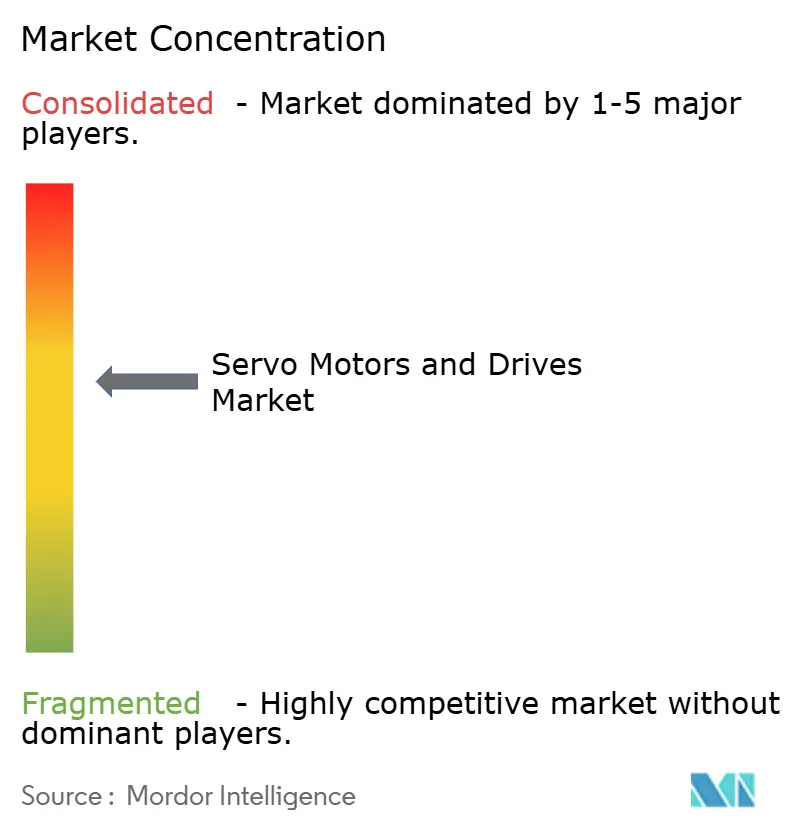
Recent Industry Developments
- April 2025: Mitsubishi Electric began sample shipments of XB Series 3.3 kV/1,500 A HVIGBT modules, cutting switching loss 15% and widening safe-operating area 25% for rail and heavy-drive inverters.
- May 2025: ECM PCB Stator Tech unveiled the “Eight Ball” servo motor with integrated harmonic drive, delivering 18.8 Nm torque in a compact form for robotics and medical devices.
- February 2025: CISA issued a critical advisory on ABB Drive Composer, CVSS 9.3, recommending users update to Version 2.9.1 to close path-traversal exploits.
- January 2025: Hitachi acquired Joliet Electric Motors to expand maintenance services and diversify recurring revenue streams in North America.
Global Servo Motors And Drives Market Report Scope
A servo motor is a simple electric motor that is controlled by a servomechanism. When a motor is used as a control device and is connected to a servomechanism, it is referred to as a DC Servo Motor. A controlled motor powered by AC is referred to as an AC Servo Motor. A servo drive is one of the fundamental components of a motion control system, which includes a servo motor, controller, and feedback element. Servo drives use closed-loop feedback to alter the voltage and current applied to the servomotor in response to a command signal for the position, velocity, or current.
The study tracks the revenue accrued through the sale of Servo Motors and Drives by various players in the global market. The study also tracks the key market parameters, underlying growth influencers, and major vendors operating in the industry, which supports the market estimations and growth rates over the forecast period. The study further analyzes the overall impact of COVID-19 aftereffects and other macroeconomic factors on the market. The report’s scope encompasses market sizing and forecasts for the various market segments.
The servo motors and drives market is segmented by type (motor [AC servo motor, DC brushlesss servo motor, brushed DC servo motor, and linear servo motor], drive [AC servo drive, DC servo drive, and adjustable servo drive]), voltage range (low voltage, medium voltage, and high voltage), end-user industry (automotive, oil and gas, healthcare, packaging, semiconductor and electronics, and chemicals and petrochemicals), and by geography (North America [United States, Canada], Europe [United Kingdom, Germany, France, and Rest of Europe], Asia-Pacific [China, Japan, India, South Korea, and Rest of Asia Pacific], Latin America, and Middle East and Africa). The market sizes and forecasts are provided in terms of value in USD for all the segments.
| Motor | AC Servo Motor |
| DC Brushless Servo Motor | |
| Brushed DC Servo Motor | |
| Linear Servo Motor | |
| Drive | AC Servo Drive |
| DC Servo Drive | |
| Adjustable / Multi-axis Servo Drive |
| Low Voltage (≤1 kV) |
| Medium Voltage (1 kV-35 kV) |
| High Voltage (>35 kV) |
| Automotive and EV Manufacturing |
| Oil and Gas (Up-, Mid-, Down-stream) |
| Healthcare and Medical Devices |
| Packaging and Labelling |
| Semiconductor and Electronics |
| Chemicals and Petrochemicals |
| Food and Beverage |
| Other Industries (Textile, Printing, etc.) |
| ?1 kW |
| 1 kW-5 kW |
| 5 kW-15 kW |
| >15 kW |
| North America | United States | |
| Canada | ||
| Mexico | ||
| South America | Brazil | |
| Argentina | ||
| Rest of South America | ||
| Europe | Germany | |
| United Kingdom | ||
| France | ||
| Italy | ||
| Russia | ||
| Rest of Europe | ||
| Asia-Pacific | China | |
| Japan | ||
| South Korea | ||
| India | ||
| ASEAN | ||
| Rest of Asia-Pacific | ||
| Middle East and Africa | Middle East | Saudi Arabia |
| United Arab Emirates | ||
| Turkey | ||
| Rest of Middle East | ||
| Africa | South Africa | |
| Nigeria | ||
| Rest of Africa | ||
| By Product Type | Motor | AC Servo Motor | |
| DC Brushless Servo Motor | |||
| Brushed DC Servo Motor | |||
| Linear Servo Motor | |||
| Drive | AC Servo Drive | ||
| DC Servo Drive | |||
| Adjustable / Multi-axis Servo Drive | |||
| By Voltage Range | Low Voltage (≤1 kV) | ||
| Medium Voltage (1 kV-35 kV) | |||
| High Voltage (>35 kV) | |||
| By End-user Industry | Automotive and EV Manufacturing | ||
| Oil and Gas (Up-, Mid-, Down-stream) | |||
| Healthcare and Medical Devices | |||
| Packaging and Labelling | |||
| Semiconductor and Electronics | |||
| Chemicals and Petrochemicals | |||
| Food and Beverage | |||
| Other Industries (Textile, Printing, etc.) | |||
| By Power Rating | ?1 kW | ||
| 1 kW-5 kW | |||
| 5 kW-15 kW | |||
| >15 kW | |||
| By Geography | North America | United States | |
| Canada | |||
| Mexico | |||
| South America | Brazil | ||
| Argentina | |||
| Rest of South America | |||
| Europe | Germany | ||
| United Kingdom | |||
| France | |||
| Italy | |||
| Russia | |||
| Rest of Europe | |||
| Asia-Pacific | China | ||
| Japan | |||
| South Korea | |||
| India | |||
| ASEAN | |||
| Rest of Asia-Pacific | |||
| Middle East and Africa | Middle East | Saudi Arabia | |
| United Arab Emirates | |||
| Turkey | |||
| Rest of Middle East | |||
| Africa | South Africa | ||
| Nigeria | |||
| Rest of Africa | |||
Key Questions Answered in the Report
What is the current value of the servo motors and drives market?
The servo motors and drives market was valued at USD 16.35 billion in 2025.
Which region leads the servo motors and drives market?
Asia-Pacific led with 46.3% revenue in 2024 and is set to grow at 7.8% CAGR through 2030.
Which product segment is expanding the fastest?
Linear servo motors are advancing at a 9.8% CAGR due to demand from semiconductor packaging and high-speed cartoning lines.
How are energy-efficiency rules affecting adoption?
EU IE4 mandates and proposed U.S. standards are driving replacements of older induction systems with high-efficiency servo packages.
Why are silicon-carbide power modules important for drives?
Silicon-carbide switches reduce switching losses and heat, enabling compact, medium-voltage servo drives suitable for high-power industrial and EV applications.
What risks threaten supply continuity for servo motor builders?
Export controls on rare-earth magnets and cybersecurity vulnerabilities in networked drives pose notable supply-chain and operational risks.
Page last updated on:
